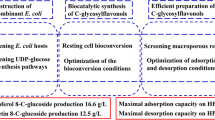Abstract
An oleandomycin glycosyltransferase (OleD GT) gene from Streptomyces antibioticus was functionally expressed in Escherichia coli BL21 (DE3) with various molecular chaperones. The purified recombinant OleD GT catalyzed glycosylation of various flavonoids: apigenin, chrysin, daidzein, genistein, kaempferol, luteolin, 4-methylumbelliferone, naringenin, quercetin and resveratrol with UDP–glucose. 4.6 μg OleD GT was readily immobilized onto 1 mg hybrid nanoparticles of Fe3O4/silica/NiO on the basis of the affinity between His-tag and NiO nanoparticles with retention of 90% activity. In batch reaction, more than 90% naringenin (20 μM) was converted to its glycoside in 5 h. The immobilized OleD GT was efficiently reused for seven times whilst maintaining >60% of the residual activity in repeated glycosylation of naringenin.





Similar content being viewed by others
References
Bowles D, Lsayenkova J, Lim EK, Poppenberger B (2005) Glycosyltransferase: managers of small molecules. Curr Opin Plant Biol 8:254–263
Choi SH, Kim HS, Lee EY (2009) Comparative homology modeling-inspired protein engineering for improvement of catalytic activity of Mugil cephalus epoxide hydrolase. Biotechnol Lett 31:1617–1624
Choi SH, Kim HS, Lee IS, Lee EY (2010) Functional expression and magnetic nanoparticle-based immobilization of a protein-engineered marine fish epoxide hydrolase of Mugil cephalus for enantioselective hydrolysis of racemic styrene oxide. Biotechnol Lett 32:1685–1691
Felgines C, Texier O, Morand C, Manach C, Scalbert A, Régerat F, Rémésy C (2000) Bioavailability of the flavanone naringenin and its glycosides in rats. Am J Physiol Gastrointest Liver Physiol 279:G1148–G1154
Gantt RW, Goff RD, Williams GJ, Thorson JS (2008) Probing the aglycon promiscuity of an engineered glycosyltransferase. Angew Chem Int Ed 47:8889–8892
Han X, Ren D, Fan P, Shen T, Lou H (2008) Protective effects of naringenin-7-O-glucoside on doxorubicin-induced apoptosis in H9C2 cells. Eur J Pharmacol 581:47–53
Kim JH, Kim BG, Kim JA, Park Y, Lee YJ, Lim Y, Ahn JH (2007) Glycosylation of flavonoids with E. coli expressing glycosyltransferase from Xanthomonas campestris. J Microbiol Biotechnol 7:539–542
Ko JH, Kim BG, Ahn JH (2006) Glycosylation of flavonoids with a glycosyltransferase from Bacillus cereus. FEMS Microbiol Lett 258:263–268
Lairson LL, Henrissat B, Davies GJ, Withers SG (2008) Glycosyltransferases: structures, functions, and mechanisms. Annu Rev Biochem 77:521–555
Lee KS, Woo MH, Kim HS, Lee EY, Lee IS (2009) Synthesis of hybrid Fe3O4/silica/NiO superstructures and their application as magnetically separable high-performance biocatalysts. Chem Commun 25:3780–3782
Lee EY, Choi SH, Kim HS (2010) Nano-immobilization of oleandomycin glycosyltransferase for preparation of glycoflavonoids. In: Hui D (ed) The proceedings of ICCE-18. International Community for Composites/Nano Engineering, Anchorage, p 256
Middleton KC, Kandaswami C, Theoharides TC (2000) The effects of plant flavonoids on mammalian cells: implications for inflammation, heart disease, and cancer. Pharmacol Rev 52:673–751
Mogk A, Mayer MP, Deuerling E (2002) Mechanisms of protein folding: molecular chaperones and their application in biotechnology. Chembiochem 3:807–814
Park SR, Yoon JA, Paik JH, Park JW, Jung WS, Ban YH, Kim EJ, Yoo YJ, Han AR, Yoon YJ (2009) Engineering of plant-specific phenylpropanoids biosynthesis in Streptomyces venezuelae. J Biotechnol 141:181–188
Quirós LM, Aguirrezabalaga I, Olano C, Méndez C, Salas JA (1998) Two glycosyltransferases and a glycosidase are involved in oleandomycin modification during its biosynthesis by Streptomyces antibioticus. Mol Microbiol 28:1177–1185
Schröder H, Langer T, Hartl FU, Bukau B (1993) DnaK, DnaJ and GrpE form a cellular chaperone machinery capable of repairing heat-induced protein damage. EMBO J 12:4137–4144
Vogt T, Jones P (2000) Glycosyltransferases in plant natural product synthesis: characterization of a supergene family. Trends Plant Sci 5:380–386
Williams GJ, Zhang C, Thorson JS (2007) Expanding the promiscuity of a natural-product glycosyltransferase by directed evolution. Nat Chem Biol 3:657–662
Acknowledgment
This work was supported by the National Research Foundation of Korea (NRF) grant funded by the Korea government (MEST) (No. 2010-0028193).
Author information
Authors and Affiliations
Corresponding author
Additional information
Sung Hee Choi and Mili Ryu contributed equally to this work.
Rights and permissions
About this article
Cite this article
Choi, S.H., Ryu, M., Yoon, Y.J. et al. Glycosylation of various flavonoids by recombinant oleandomycin glycosyltransferase from Streptomyces antibioticus in batch and repeated batch modes. Biotechnol Lett 34, 499–505 (2012). https://doi.org/10.1007/s10529-011-0789-z
Received:
Accepted:
Published:
Issue Date:
DOI: https://doi.org/10.1007/s10529-011-0789-z




